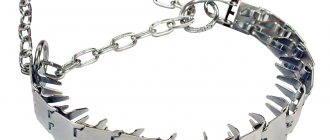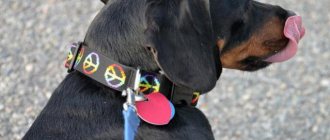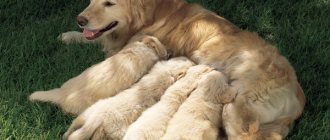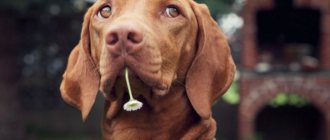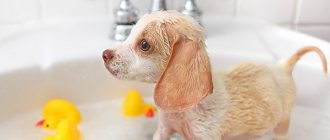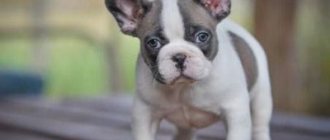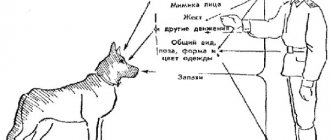Type
Classic - used for everyday wear. This product is made of leather or synthetic materials. A good choice for calm dogs. There are three types of classic collars:
- for walking – equipped with a soft lining and a half-ring for attaching a leash, most common;
- for protective guard service – has a special handle and an additional half-ring for fastening the dog during protective training (on a leash);
- guard collar - the most durable collar due to its special design (the belt passes through a half ring and is fastened with a buckle).
Parfors (strict) is a special collar designed for training usually large and aggressive breeds of dogs. Made of metal. A distinctive feature of parfors is the presence of spikes or plates located on the inside. This product causes mild pain and discomfort to the pet when the leash jerks.
Important: it is recommended to use a strict collar only after consultation with a dog handler. This will avoid health problems that parforce can cause. Also, the collar cannot be used constantly, as this will cause an aggressive reaction in the pet. The opposite effect is also possible: the dog gets used to the discomfort over time, which means the product will lose its disciplinary effect.
Noose (jerk) - like parfors, it is used only for training. The choke collar tightens when the leash is pulled and thereby compresses the dog’s neck. True, some models are also used in everyday use - these products are made in the form of a strip with rings at two ends. Such nooses are transformed into classic collars that do not allow for tightening.
Important: a garrote can pose a health hazard to your dog. It is strictly forbidden to leave the animal in this collar without supervision and on a leash.
Half noose (martingale) – designed for everyday use. It consists of a long strip with rings at two ends and a shorter one, which is threaded into these rings and to which the leash is attached (through the corresponding ring). When the leash is pulled, the half-choke is tightened to a certain length and does not squeeze the neck. The Martingale fits securely around the dog's neck and is easy to put on and take off.
Chain – a metal collar consisting of many links. Chain collars can be used for show or pleasure purposes. There are also choke chains and half-choke chains that have the same characteristics as similar models made of leather or synthetic materials. Single-, double- and triple-row chains are available on the market. Products with 2 or 3 rows are used only at exhibitions.
Important: the larger the chain link, the less such a collar spoils the dog’s fur. Therefore, models with large links are recommended for long-haired pets.
Decorative - decorated with various decors, for example, rhinestones. This product looks great and emphasizes the individuality of the animal and its owner. Disadvantages: quite high cost, risk of a dog or cat swallowing a torn decorative element. Purchased for some breeds participating in exhibitions. Decorative collars are not designed for daily wear.
Important: when choosing a decorative collar, consider the method of attaching the elements. Rhinestones fixed with glue will quickly come off. If the decor is attached with metal legs, then such a collar can catch the animal’s fur. It is better to choose a model in which the rhinestones are located in plastic cells.
An electronic collar is an innovative collar that allows you to train a dog and track its location (if it has a GPS tracker). Due to its advanced functionality, such a collar controls the behavior of the animal (“anti-bark”, “remote influence”). Operates on batteries or accumulator. The disadvantage is the high price. Optimal for training aggressive dog breeds, including hunting dogs
Flea and tick collar – protects dogs and cats from these parasites.
Important: buy a collar from well-known brands that value their reputation. Carefully inspect the accessory for defects and make sure it is durable. The buckle and half rings (rings) must be welded, the fastener must be reliable, but at the same time convenient to unfasten and fasten.
Which collar is best for a puppy?
Puppies, especially large breeds, tend to grow. As it grows, the circumference of your pet’s neck also increases greatly. To avoid having to change your collar every month, it is better to give preference to collars with a wide range of adjustment. These can be strap collars with a lot of holes for fastening, but when the puppy is small, the long tail of the collar will stick out and get in the way. It also looks a little untidy. Therefore, in this case, it is better to give preference to nylon collars with a wide range of adjustment, for example, the Hunter Alu-Strong collar in size L is adjustable from 45 to 65 cm. This reserve is quite enough for a Labrador puppy from 2 months to adulthood. Plus, nylon is easy to wash, soft and comfortable for your puppy.
At what age can you wear a collar?
The puppy must be accustomed to wearing a collar from the very first months. An adult dog has difficulty getting used to this accessory, and, most often, this is expressed by aggression. Many owners whose pets are kept in kennels around the clock do not consciously devote time to accustoming their puppy to a collar. They are sure that with such a lifestyle, the pet will not need this skill, since he makes all his walks without a leash in the enclosure territory, and, according to the owners, this is enough for him. But there comes a time in every dog’s life when it has to pay a visit to the veterinary clinic. And for this you need to wear a collar, leash and even a muzzle. And at such moments, the owners really regret that they did not accustom their pet to this accessory in time.
The collar must be put on the puppy before a walk, positively reinforcing his good behavior with a treat. This way, this item will evoke only good associations for him (treats, encouragement, walks, outdoor games, etc.). Thus, the pet will quickly and easily get used to the useful accessory.
It is important to remember that the dog should only wear the collar during walks, and cannot be worn around the clock. The wool underneath will rub off and bald spots will appear.
Which collar to choose for your dog?
The choice of this accessory depends on the purpose for which it is needed:
- For daily walks, a wide soft collar made of nylon or leather is suitable. If you have a German Shepherd, then it is better to buy a chain with elongated links;
- to complete the OKD course. Most often, dog handlers ask to bring their pets to classes in snatch chains or garrotes;
- for correcting the behavior of aggressive dogs. The so-called strict collars - parfors - are suitable for these purposes. They should be used only after consulting a specialist, who will confirm that the pet really needs it and show how to handle it correctly. Do not try to take measures to correct the psyche on your own and do this without the supervision of a professional. Such actions can only make the problem worse;
- ringovki. Such collars are necessary for dogs that take part in an exhibition and go through the ring. They are made from various materials - steel, nylon, leather and others. The choice is based on the individual characteristics of the breed. For example, for large breeds, ring chains are most often chosen.
Size
Maximum length – indicated for models that can be unfastened. A correctly chosen collar does not put pressure on the dog’s neck, does not dangle, and especially cannot be removed over the head.
The length of the collar is selected based on the circumference of the tailed friend’s neck, which is determined using a measuring tape. In this case, it is necessary to place the index finger between the tape and the neck of the animal (for medium and small breeds) and two fingers (for large breeds). Add 5-7 cm to the result obtained.
Choosing a collar by length will be made easier by a special table that shows standard sizes and the corresponding dog breeds. Thus, models of size S (height at withers 31-37 cm) are suitable for Yorkshire terriers, Pekingese, and toy poodles, and collars of size L (height at withers 49-60 cm) are suitable for Great Danes, Labradors, and black terriers.
Height at the withers refers to the distance from the ground to the withers - the highest point of the back in dogs and cats.
Important: the maximum length of collars is indicated in a certain range, for example, 40-65 cm. This information is approximate. Therefore, such an accessory may not be suitable for animals with a neck of 40 cm or 65 cm. Focus on the middle of the size range - this will be the best option (52-53 cm).
Circumference length - given for collars that do not unfasten (half-choke). The desired size is also determined using tape.
Width – selected depending on the temperament and breed of the dog. Large animals will need a wider accessory than small ones. This indicator also affects the strength of the product: the wider, the less likely the dog will break the collar. But a narrower model is better suited for training, as it cuts into the dog’s skin more strongly when jerking.
A smart choice lies in the middle: an accessory that is too narrow rubs the skin, while an accessory that is too wide “wipes” the fur and causes friction on the skin, and also limits the freedom of movement of small dogs.
Types of puppy collars
Each type of collar has a specific function. We will consider common types of collars below.
Tapes for newborns
Multi-colored newborn puppy ribbons are used to differentiate between babies.
Using ribbons they indicate:
- Boys and girls.
- The first and last puppy born.
- Puppies that are lagging behind in weight gain.
Multi-colored ribbons are used for the convenience of the owner and photo shoots. Usually, so that accessories do not interfere with the puppies and the young mother, satin ribbons are used, which are tied in secure knots.
Casual collar
An everyday puppy collar is an accessory that is used for training and identification. For an everyday collar, accessories made of lightweight fabric, usually nylon, are chosen. Heavier, leather collars, suitable for large breed puppies.
Advice! Collars in the form of chains, choke collars and ring collars are not suitable for puppies under 10 months of age.
An everyday collar should be comfortable and safe. Simply put, the puppy should not notice that there is anything on his neck.
Walking collar
A walking collar should be durable, wide enough and light. Depending on the size and physical strength of the puppy, collars with plastic or metal fasteners are selected. The walking collar must have a strong metal ring for attaching the leash.
Note! For walks with puppies of small breeds and dogs with a wide chest, in puppyhood, not collars, but harnesses are recommended.
Preventive collar against fleas, ticks and parasites
Preventive collars against fleas, ticks and parasites are an auxiliary accessory that allows you to protect your pet. It is important to understand that collars alone do not help get rid of parasites. Anti-parasitic collars prolong the effectiveness of flea and tick drops, shampoos, and sprays.
Material
Nylon - combines practicality, light weight, strength and low price. The nylon collar does not cause allergies. The disadvantage is that some models stain the animal’s fur and stretch when exposed to moisture. Such products are chosen by puppy owners, novice dog breeders and dog owners who do not plan to train their pets. Nylon is also used in the production of cat collars.
Important: a nylon collar is not suitable for hunting and fighting dogs, as well as large and heavy four-legged friends.
Leather is a reliable, durable and impressive-looking material. Disadvantages: high cost, sensitivity to UV rays, moisture and freezing temperatures, the need for regular treatment with special compounds. Leather collars are considered the most comfortable for dogs.
Important: do not buy a cheap leather collar. Such products quickly burst and stretch. It is recommended to choose a model made from a single piece of leather with water-repellent impregnation. A sign of a quality product is the presence of double seams on the outside of the collar and the use of thick thread.
Leatherette – artificial leather. Compared to leather collars, such products are cheaper and more practical, as they do not require special care. Disadvantages: reduced strength, modest appearance. Sometimes wearing such a collar for a long time causes discomfort and allergies in dogs.
Metal is the strongest and most durable material and has an attractive appearance. Disadvantages: high cost, difficulty in selecting the optimal type of weaving of the collar chain (the characteristics of the dog’s fur are taken into account). Some metal models stain light wool and rust with prolonged contact with water. Metal collars are suitable for large and heavy dogs.
Important: To prevent corrosion of the metal collar, dry it thoroughly after finishing your walk.
Biotan is nylon in a plastic shell. Resistant to wear, not afraid of UV rays, low temperature and moisture, easy to clean from dirt. The downside is the relatively high price (compared to nylon collars).
Rubber is an inexpensive and hypoallergenic material, resistant to moisture, high and low temperatures, and does not fade in the sun. Rubber models are often equipped with light-emitting diode (LED) bulbs or glowing phosphor tubes. These collars are chosen for small animals.
Plastic is a very cheap material. The main disadvantage is that you cannot adjust the size of the neck circumference. Therefore, this collar is strictly forbidden to be worn on growing animals. Yes, and for adult pets it is better to choose a model made of higher quality material.
Tarpaulin is a budget and reliable solution. Disadvantages: sensitivity to moisture, unaesthetic appearance. Canvas collars are used if there are no other alternatives.
How to find out the size of a dog collar?
To determine the size of your dog's collar, you first need to take measurements. Dog handlers offer several different ways to measure the size of an animal’s neck:
We measure the base of the dog's neck (for this you can use a soft meter or a thread, the length of which can then be measured with a regular ruler). To prevent the collar from being too tight, insert one or two fingers between the meter and your neck when taking measurements. Remember the result in centimeters. We measure the middle of the neck (approximately the place where the collar will be worn), then add 5 centimeters to the result. In the case of a chain and a noose, it is recommended to add 6-7 centimeters. Using these data, you can choose a comfortable collar based on standard sizes:
- XS = 15 – 28cm
- S = 35 – 43cm
- M = 40 - 48cm
- L = 45 – 52cm
- XL = 52 – 60 cm
- In the case of a strict neck, measure directly under the throat (at the place of wearing);
- To select a noose, you need to measure the widest part of your head (since it is put on through it);
- If you are choosing one for a puppy, then, of course, you should take an adjustable one with the possibility of increasing the size.
Do you need a fitting?
In general, dog experts agree that fitting for purchase is not so necessary. It is enough to take the described measurements for each individual type of collar.
Collar cleanliness
To maintain the cleanliness and appearance of the collar, the material from which it is composed is primarily important. Iron ones can be washed and disinfected, synthetic and fabric ones can be washed. With leather, this is best avoided as much as possible, as the material will dry out and deteriorate. Leather can be treated with special compounds, which will also increase their moisture resistance.
How to accustom a puppy to a collar?
Put a collar on your dog from a very early age - this way it will organically become part of the puppy’s understanding of the world and will facilitate his subsequent training. At the beginning, the puppy may whine a little, bark and try to get rid of it - give it time to get used to it.
Specific collars
Technologies are constantly evolving, including new and interesting solutions for pets. Two more types of collars that have become possible thanks to progress:
Collars with a navigator were originally invented for hunting dogs that had to go long distances from the owner. Nowadays, owners are increasingly purchasing them for their pets. The most important function is to search for a lost dog. The main drawback is the price. A vibrating collar reacts to barking or other unwanted behavior of a dog and allows you to wean your pet off it in a short time.
Currently reading:
- Games to choose for training a dog
- The American Cocker Spaniel is an adroit hunter and loyal friend.
- Seven Signs and Remedies for Getting Rid of Fleas in Dogs
- Tips for proper dog burial
Clasp
The buckle is a reliable fastener that prevents accidental unfastening. Cons: lack of fine length adjustment; when fastening, there is always a protruding tail, which irritates the dog (the animal often chews it off).
Fastex - unlike a buckle, provides fine adjustment of the length and looks more aesthetically pleasing, since there is no protruding tail. The downside is the likelihood of accidental unfastening and breakage with a strong jerk. To reduce these risks, do not buy a cheap collar with a fastex latch.
The lock can withstand heavy loads and is easy to use. Parfors and some expensive classic models are equipped with a lock.
Sometimes there are collars with a carabiner. This is a reliable clasp that simplifies the fastening and unfastening of the product. It is used in parfors and half-strikes.
Clasp material
Metal is strong and durable. Disadvantages: high price, risk of corrosion. A collar with a metal clasp is suitable for any dog. First of all, this solution is relevant for large and aggressive breeds.
Important: To avoid corrosion, choose a collar equipped with a stainless steel clasp.
Plastic is cheap and does not rust. The downside is fragility. A model with a plastic fastener is chosen for small and calm dogs.
Metal + plastic - combines the advantages and disadvantages of these materials. This option is not widely used.
Polyurethane – found in decorative collars.
Peculiarities
Adjustable length – makes it possible to accurately adjust the collar to the size of your pet’s neck.
Luminous – makes it easier to walk your dog without a leash in the dark. This collar allows you to keep your four-legged pet in sight at a distance of up to 400-450 m.
Reflective - increases the visibility of the dog at dusk or at night, which reduces the risk of a car hitting it. A useful option if the animal walks near highways.
Waterproof - does not absorb moisture and has a water-repellent effect. This accessory is used when bathing a dog in a pool, lake, river or other body of water. The waterproof collar is also suitable for humid climates.
With soft lining – provides the dog with the most safe and comfortable wearing of the collar.
With an address book – helps to find a lost dog or cat. The address book contains the contact information of the animal owner (telephone, home address)
With a handle – makes it possible to control the dog by holding it by the collar without using a leash. Collars with handles are most often chosen by dog handlers.
An energetic dog should purchase a collar with an extension under the neck. This design feature reduces the pressure on the animal’s throat during sudden jerks.
Functions
Anti-bark – triggers when dogs bark and howl. In case of appropriate sounds, a special correction system acts with a vibration signal, ultrasound, electric discharge or spray, causing discomfort to the dog. As a result, the animal weans itself from barking for no reason due to the formation of a conditioned reflex (barking means discomfort). Such methods are safe for the dog’s health.
The anti-bark option can be implemented in different ways depending on the specific model:
- vibration+ultrasound+electric shock;
- vibration + electric discharge;
- ultrasound + electric shock.
Advanced accessories with an “anti-bark” function provide remote control, automatic shutdown for frequent and loud barking, and automatic adjustment of the correction level based on the pet’s temperament.
Beeper - allows you to determine the location of the dog. When the animal moves or stops (stands), the beeper emits special sound signals that can be heard at a distance of 300-500 m. This option greatly facilitates the interaction between the owner and the hunting dog.
Remote influence (training) – corrects the dog’s behavior at a distance through an electrical impulse. Collars with this function are equipped with a remote control.
Training collars
Ammunition that can correct a pet’s behavior is purchased in two cases:
- if a disobedient animal periodically has to be walked by people who are physically unable to cope with it;
- if you need an effective training tool.
If you buy a collar for a shepherd in which it cannot actively pull and use it daily, the dog will get used to the discomfort, build up its muscles, and the problem will return. Such devices are used to more effectively influence the animal and achieve the desired results from it. Or if a person who is physically unable to hold the animal occasionally has to go out with the pet.
To determine which collar is best for a German Shepherd, Rottweiler, or any other large dog that has not completed a general training course, you need to know the main types of such equipment.
Halter or halti
The halter is otherwise called “Halti” in honor of the company that first produced this device. On a dog, it looks like two loops placed around the animal’s neck and mouth, connected by straps located on the cheeks. With all this, the leash is attached to the bottom of the loop located on the bow.
This design prevents the dog from pulling on the leash . If she tries to do this out of habit, her head will turn back. This is inconvenient, and you simply can’t see where to run.
Among the advantages of such a device are gentle correction of behavior and the establishment of eye contact with the pet, since the owner can control the movements of the pet’s head. In addition, for many people, a loop on a dog’s nose is associated with a muzzle, although it does not perform this function at all - the animal’s mouth opens freely. If the owner for some reason cannot use a muzzle (for example, the puppy is not yet grown enough), and those around him are worried, the halti will help avoid many claims.
But the halter also has disadvantages. For example, the need to clearly select the size (otherwise it will have no effect) and its absence in the assortment of most pet stores. According to reviews from owners, many pets experience stress when using such a device and become lethargic and passive. But if you accustom your dog to Halti gradually, it can provide significant assistance in raising the animal.
Parfors with thorns
A metal ring of links with spikes inside is called a parfors or a strict collar. To be used effectively, it should be placed at the highest point of the dog's neck, just behind the ears. But at the same time, it should not wrap around the neck too tightly and cause discomfort when the animal is at rest.
The principle of its operation is simple. When the dog follows the command, the parfors does not cause pain to it. As soon as she starts to pull, the spikes dig into her neck.
Decoration
When designing decorative collars, rhinestones, scarves, spikes, rivets, sparkles, appliqués, and bells are used. A variety of design solutions allows you to choose an accessory that distinguishes your dog from its fellow dogs and emphasizes the advantages of its appearance.
Some decorative elements also have practical significance. The scarf is soaked with moisture to protect the pet from overheating or with compounds to repel worms and other parasites. And the bell will signal the owner about the movement of his pet.
Important: to avoid injury to the owner and other dogs during play, you should not buy a product with spikes. Also, avoid purchasing a collar with overloaded decor - this model will cause inconvenience to the animal.
Collars for everyday wear are most often made without decoration.
Functions of a dog collar
Every dog owner should take care of a collar for their pet. This product performs several functions:
- A leash is attached to the collar, which allows you to keep the dog’s movements under control.
- If you walk freely, without a leash, your pet may get lost. You can attach a tag to the collar with the pet’s name and the owner’s phone number. Even if this was not done, a leather ring around the neck will indicate that the animal is not stray. People will pay attention to the dog, and it will be much easier to find.
- The collar also has a decorative value. It is made of leather, metal, plastic and other materials, and can be of various types, colors, and sizes.
- There are many types of dog collars. Some of them can help correct your pet's behavior. For example, if he pulls hard or constantly tries to eat some garbage from the ground.
But collars are different, and you need to be able to choose them correctly.
Manufacturer
You should be careful when choosing a collar manufacturer, since low-quality products can play a fatal role in the life of a pet. First of all, you need to pay attention to the fastener, especially if it is fastex. Cheap plastic latches can come undone with very little effort. Therefore, you should definitely test the collar for the dog’s weight outside. It is worth noting that weak fastex can be found among the products of fairly well-known brands.
The cheapest models are from local little-known brands Kristel, My Wuf, AnimAll. Among the disadvantages: they quickly lose color and appearance (they wear out and get worn out), the likelihood of accidental unfastening of the fastex. Such products should be purchased only for short walks of very calm or older dogs. A similar collar is also suitable if the dog is walking in the yard of a private house. An active, young or overly aggressive dog can run away if a fastener breaks, get lost, get hit by a car, get into a fight, and so on. We strongly do not recommend purchasing these collars if you have just such a dog.
Collars from Coastal, Rogz, Collar, Ferplast, Hunter, PetSafe, Show Tech, Sprenger, Trixie have a good price-quality ratio. As a rule, reliable fasteners and high-quality materials are used. However, one must also pay attention to the pricing policy of a particular brand. Many brands have budget lines - this is where you can find defective fastex, crooked seams, inconsistencies with the size chart and even other shortcomings.
The most expensive collars are the Hurrta models - very reliable, high quality, but their prices are high.

